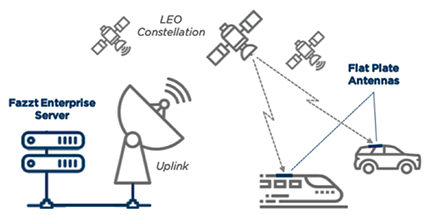
Presenting their technologies at NAB 2019 is KenCast, who will be resident at booth SU11415 at the Las Vegas Convention Center from April 8 through 11.
The company will be presenting their enhanced Fazzt content delivery platform.

KenCast’s Fazzt® software is ideal for the most up and coming space-based network solutions as these satellites offer:
1. Low latency – High-throughput satellites (HTS) within a GEO satellite network send signals that take a quarter of a second to reach their destination. For TV broadcasts, GEO satellite latency does not make a difference. However, for applications that require real-time responsiveness, such as military communications, trading, banking, and more, lower latency is required. LEO and MEO satellite networks are closer to the Earth than GEOs (22,236 miles), which means the latency is lower. A MEO satellite network can reduce latency from 250 to 6 milliseconds, which is the same latency as a terrestrial fiber optic network. Some LEO and MEO satellite networks are connected by optical inner-satellite links (ISLs), which create a fiber-like connection between the orbiting satellites at speeds of 1.6 Gbps and 5.2 Gbps. The resulting service will have lower latency and a much lower cost than terrestrial fiber networks.
2. More bandwidth – Because a LEO/MEO satellite network is closer to Earth’s surface than a GEO, it can handle a much greater bandwidth. In 2015, the military tested a commercial satellite network that could potentially provide 300 times the amount of bandwidth than current satellite networks. This solution is ideal for mobile platforms, which could support services like live streaming video from a military drone. As LEO/MEO satellites can virtually cover the entire surface of the Earth, they are well-suited for areas with no terrestrial connection. Cruise ships, navy warships, and schools in developing countries will benefit from this innovative satellite network technology.
3. More resiliency – A LEO/MEO satellite network is highly resilient. Tight security has always been important to the military, public safety, digital cinema, and other big industries. But GEO satellites are vulnerable to jamming, when the free flow of information is stopped by a bad actor. Jamming a satellite network can only be accomplished from within the beam, so the the smaller the beam, the harder it is to jam. LEO/MEO satellites use far smaller spot beams. In addition, there could be hundreds to thousands of satellites in a LEO/MEO network, compared to just a single GEO satellite. For example, at a given time, there could be two to three LEOs in line-of-sight. What’s more, because the lower altitude of these orbits requires a very high velocity, any given satellite may only be overhead for an hour or so. This makes the network inherently redundant and far more difficult to attack. Plus, LEO/MEO satellites are much less costly than GEOs, so it is also affordable to place a number of spares in orbit to recover from the failure of even multiple, primary satellites.
KenCast will demo their strong support for applications with very large files and video streaming:
- On the new High Throughput Future-Satellite-Networks – LEO, MEO and GEO
- To vehicles on the move (planes, ships, cars, trains, buses) and fixed sites
- Employing wireless hybrid 5G (with eMBMS/LTE-B) & satellite networks
- Delivering 4K/8K files and live video streaming securely and with hi-reliability
- Using 64-bit highly efficient operation that handles even the big 8K cinema movie files

